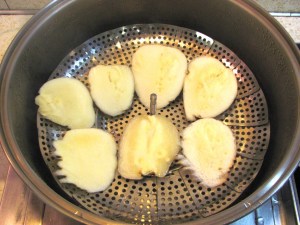After a week of heavy rain, the garden was about as soggy as it gets–just right for extracting tenacious parsnip roots from the earth.
 So between showers I put on my muck boots and tackled the row. Last year’s foliage has all died back now. Little fresh green shoots are just thinking about sprouting from the tops, so it’s time to bring them in before the new growth saps all the goodness from the vegetable.
So between showers I put on my muck boots and tackled the row. Last year’s foliage has all died back now. Little fresh green shoots are just thinking about sprouting from the tops, so it’s time to bring them in before the new growth saps all the goodness from the vegetable.
The trick for getting parsnips out of the ground is to dig a fork-full of dirt away from the side of the roots. It’s too easy to damage the the root with the fork if you attack it straight on. Pull the top of the root toward your excavation, grab hold firmly and PULL. Nothing works as well as your muddy hand! The variety that I’m growing are a German type called Halblange Wiesse (half-long white). When you are wrenching them from the ground, you appreciate that they are only “half-long” and have a good taper.
I pulled about three feet of row, got my bucket full of ‘snips and managed to get soaked as another downpour helped me hose them off. Just as I finished, the sun peeked out for the photo.
 I’m going to raise more seed again this year. The easy way to grow parsnip seed is just to leave them in the ground and let them grow again in the spring. This time I want to more carefully select the roots for planting again later. I always look for nice shaped roots to plant for seed, but selecting for flavor is not as easy.
I’m going to raise more seed again this year. The easy way to grow parsnip seed is just to leave them in the ground and let them grow again in the spring. This time I want to more carefully select the roots for planting again later. I always look for nice shaped roots to plant for seed, but selecting for flavor is not as easy.
So after I cleaned them all, I picked out a dozen and a half nice looking ‘snips, and snipped off a piece of the shoulder on each root. In batches of a few pieces, being careful not to mix up which root they came from, I steamed the sampled sections. It was lunch time, so I did a taste test. 
There was definitely a significant flavor variability in the samples. Nothing was bad, but some were better! I culled about a third of the ones I sampled. Those will still make some good roasted roots, or part of a vegetable soup. The winners are bagged up in the vegetable fridge ready to go back in the ground again. I plan to do the same thing again for the next couple of harvests to get around thirty roots to provide adequate genetic diversity for this year’s seed crop.
Viable seed life for parsnips is only about a year. Maintaining the variety quality of an out-breeder like parsnips means you have to grow quite a few plants all the time and be continually selecting for the best. Doing this every year to ensure good germination produces quite a bit of seed — far more than I could ever use.
Which is why we have seed swaps. Out-breeders especially, like the brassica (broccoli, Brussels sprouts, cauliflower, etc.), corn, carrots and parsnips require 30 to 50 plants (more for corn) each time you grow for seed to maintain sufficient genetic diversity and avoid inbreeding depression. Even growing one or two of these crops for seed can require more space than a home gardener is willing to give, and then there will be way more seed than the grower can possibly use before it loses vitality. But when serious gardeners each pick one or two varieties to shepherd, and then bring the surplus seed to local seed swaps, we all benefit from each other’s efforts.
If you want to enjoy the fruits of my effort, you can find my parsnip seed at the seed swaps I attend in Eugene, or from Adaptive Seeds.

I hope you’ll give a heads’ up when it is time to plant the parsnip seeds! Those look spectacular, what a reward!
Alas, I probably can’t do a seed swap, but I can recommend a nice use for those parsnips!
Parsnip Puree
1 pound parsnips, peeled and sliced
Salt
2 C heavy cream
2 sprigs fresh thyme
1 head garlic, cut in ½ horizontally
4 ounces unsalted or extra-virgin olive oil
Freshly ground black pepper
1. Put parsnips in pot, season with salt and cover with water. Place over medium heat and bring to a simmer. Cook until tender – the tip of a paring knife should easily go through without resistance, approximately 15 minutes.
2. In a medium saucepan place the cream, thyme sprigs and garlic cloves over low heat and bring to a simmer.
3. Drain parsnips and reserve cooking liquid. Place parsnips in a food processor with butter, or extra-virgin olive oil and a couple of tablespoons of reserved cooking liquid. Begin to process and add strained heavy cream mixture. Season with salt and pepper, to taste, and puree until very smooth.
OK Becky, I’ll give a heads up when I plant this spring.
Bo, Looks yummy! How could it be bad with all of that cream!